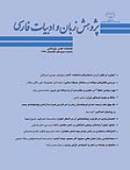حافظ و هویت فرهنگی ایران
محورهای موضوعی : پژوهشهای ادبیات کلاسیک ایران
1 -
کلید واژه: هویت ایرانی حافظ, اسطورههای ایرانی جام جهان بین مانویت,
چکیده مقاله :
این مقاله به بررسي هويت فرهنگي ايران در قالب اشعار حافظ ميپردازد و درصدد اثبات اين مطلب است كه حافظ به تقابلهای فرهنگی و نمودهای آن در زبان و عصر خود، توجه ويژهاي داشته است. ترکیباتی چون پیر مغان، جام جم، مانویت و شادی و مضامین برگرفته از شاهنامه، چون ننگ و نام و... ریشه-های تاریخی و اسطوره ای اين اشعار را در ایران پیش از اسلام و ایران پس از اسلام نشان ميدهد. سپس به بررسي جلوه ها و نشانه های فرهنگ ایرانی اسلامی در شعر حافظ میپردازيم و با تحلیل بیت های دارای این نشانه ها، تلاش حافظ را در پیوند ميان این مفاهیم با هویت ایرانی-اسلامی که موجب استحکام مرزهای جغرافیایی تازه ای در میان مردم ایران شده است، بيان ميكنيم.
The present article surveys Iran's cultural identity in terms of Hafiz' poetry. It is to prove that Hafiz paid especial attention to the cultural oppositions of his time and their manifestations in his language. The expressions such as Pir-e-Moqan (the Magian Elder), Jam-e-Jam (the world-displaying cup) Manichaeism, joy, and contents adapted from Shahnameh are indicative of the historical and mythological roots of Hafiz' poems in pre and post-Islamic Iran. The article studies the signs and traces of Persian-Islamic culture in Hafiz' poetry, and analyzing the lines having these signs, shows Hafiz' attempts to establish links between these concepts and the Persian-Islamic identity which caused strengthening the new geographical borders of Iran.


